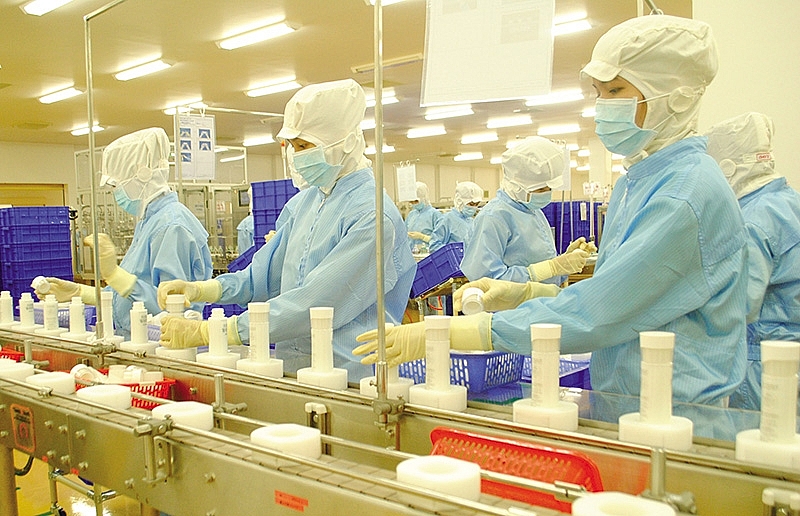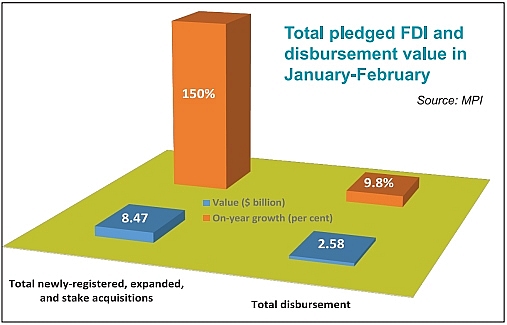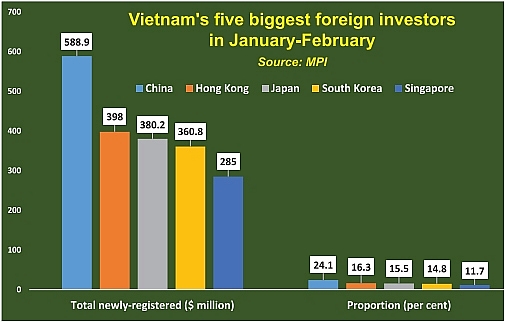Japanese firms urge business reform
 |
| If infastructure and business conditions were to improve, more Japanese investors would consider relocating to Vietnam, Photo: Le Toan |
Infrastructure, supply chains, and the quality of labour force remain the top concerns for Japanese businesses seeking improvements at last week’s meeting between the Japanese Chamber of Commerce and Industry in Vietnam (JCCI) and the Vietnamese Ministry of Planning and Investment (MPI).
“Transport infrastructure and electricity transmission are yet to be developed well, while the number of local suppliers remains inadequate, leading to imports of spare parts, thus increasing production costs,” said Hidekazu Oshita, general secretary of the Japan-Mekong Business Corporation (JMBC) under the JCCI.
“Moreover, Japanese enterprises are still concerned about the lack of intermediate managers and high-quality workforce, as well as the changeability of policies. Also, it is time for Vietnam to develop supporting industries.”
Full of potential
As the leader of one of the companies accompanying the JCCI to the MPI, Takaharu Oyama, general director of A&D Vietnam Limited, one of the companies which recently shifted investment from China to Vietnam, agreed that increased production costs driven from the import of spare parts is a big concern. “To ease risks, profit is not a big issue at first. However, it gains relevance when the decision on shifting from China and Thailand to Vietnam is made.”
These issues have been around for years. However, this time, the JCCI aims to prepare for a possible redirection of Japanese investment from China and Thailand, as well as for the development of new industries.
According to a recent JCCI survey of 15 powerful Japanese companies which have investments in all three nations, Vietnam’s main advantage over the two other countries is its cheap labour costs.
Japanese businesses also highlighted the Vietnamese government’s policies for the development of supporting industries. Against Thailand, the country has advantages in domestic consumption and stable and high economic growth.
“There are more Japanese enterprises mulling over shifting investment from China and Thailand to Vietnam to benefit from the Comprehensive and Progressive Agreement for Trans-Pacific Partnership (CPTPP) and to ease risks from US-China trade tensions,” Oshita of JMBC elaborated.
Being the only country in the region to join the CPTPP, Vietnam has emerged as an attractive destination for Japanese firms in their “China + 1” and “Thailand + 1” strategy. The agreement opens up new opportunities for foreign direct investment (FDI) and exports thanks to tariff cuts and new regulations in the fields of e-commerce, product origin, intellectual property, and state-owned enterprises.
With the CPTPP and its high growth potential in domestic consumption thanks to a population of 100 million and strong linkages to the Southeast Asian market, the country has all the conditions to become a manufacturing base for global exports to Japanese investors, especially when considering the growing demand for exports of high-tech products, e-commerce, and fresh food, as well as high investment co-operation prospects in tourism, IT, and high-tech agriculture.
With high hopes, the Japanese government has estimated that the CPTPP with Vietnam and 10 other members would contribute to expanding Japan’s GDP by 1.49 per cent. In the case of 12 members, the figure would be 2.49 per cent.
Professor Koichi Ishikawa from the Institute of Asian Studies under the Asia University of Japan, said that Japan’s GDP would expand less through the CPTPP without the US, but 1.49 per cent is still a significant figure for the Japanese economy, considering the recent low growth rate.
 |
 |
Challenges remain
Thus far, to ensure the market for Japanese enterprises and to promote trans-national trade co-operation, the Japan External Trade Organization (JETRO) about two years ago kick-started the Pilot Project for Nurturing New Industries between the ASEAN and Japan. The new industries focus on digital technology, healthcare, the Internet of Things, and services. Following this, NTT Data, TBA, Toppan Forms, and many other companies are planning to carry out new projects in Vietnam.
Recognising stiffening competition in FDI attraction amid global changes, Vu Dai Thang, Deputy Minister of Planning and Investment, affirmed that Vietnam will continue to improve its business climate, thus further facilitating Japanese investors and others.
However, to increase Vietnam’s attractiveness, which the JCCI said still ranks 4th in terms of the number of Japanese projects overseas (equal to one eight of China), addressing these issues cannot be done overnight.
Let’s take infrastructure as an example. The nation’s investment in infrastructure has averaged at 5.7 per cent of GDP in recent years, the highest in Southeast Asia and the second in Asia after China at 6.8 per cent. Meanwhile, Indonesia and the Philippines spend less than 3 per cent and Malaysia and Thailand spend less than 2 per cent of their GDP on infrastructure.
Despite the huge investment, infrastructure has yet to meet high requirements from investors. Annually, concerns are raised by Japanese and other investors alike.
Now, the government is striving to improve the situation by requiring good infrastructure in order to attract companies to set up factories. The development has been fairly spread out, with airports and roads being built throughout the country.
The challenge is that the country needs about $480 billion through to 2020 to build power plants and highways, which requires more private sector involvement as the state budget can only meet a third of the financial requirements. One of the solutions for this is to effectively amend the Law on Investment 2014 and the Law on Enterprises 2014. This could be done in addition to the Law on Public-Private Partnership to remove all barriers that are now hindering private investment in the field.
What the stars mean:
★ Poor ★ ★ Promising ★★★ Good ★★★★ Very good ★★★★★ Exceptional
Related Contents
Latest News
More News
- Solid finish for manufacturing after volatile year (January 06, 2026 | 08:50)
- Meiko strengthens Vietnam operations with new PCB plants (January 06, 2026 | 08:49)
- Ho Chi Minh City backs $2 billion AI data centre with dedicated task force (January 06, 2026 | 08:43)
- PM sets January deadline for high-speed rail consultant (January 06, 2026 | 08:40)
- New decree spurs on PPP implementation (December 31, 2025 | 19:01)
- Global alliance develops $1 billion AI data centre network in Vietnam (December 30, 2025 | 10:08)
- Standing out in the Chinese outbound investment wave (December 29, 2025 | 10:29)
- Bright spots obvious in foreign investment mission (December 29, 2025 | 09:00)
- Ho Chi Minh City hits $8.37 billion in FDI (December 29, 2025 | 08:28)
- Vietnam and UK cooperation backs finance talent for IFCs (December 27, 2025 | 16:31)

 Tag:
Tag:





















 Mobile Version
Mobile Version